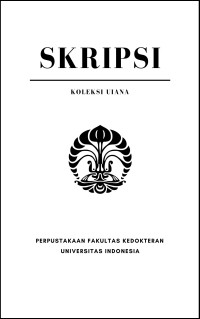Skripsi
Analysis of Liver Fibrosis in CCl4-Induced Rat Liver by Administering Different Doses of Umbilical Cord-Derived Mesenchymal Stem Cell = Analisis Fibrosis Hati Tikus Perlakuan CCl4 dengan Pemberian Dosis Sel Punca Tali Pusat yang Berbeda.
Background Liver fibrosis is the excessive accumulation of extracellular matrix proteins including collagen that occurs in most types of chronic liver diseases. Previous studies have shown that the injection of mesenchymal stem cell is beneficial to alleviate liver fibrosis. However, the optimum dose of stem cell that must be administered is not yet fully understood. Previous research used 1 x 106 stem cells to treat 2AAF/CCl4 – induced rat liver which simulates a chronic liver injury. Results show that the degree of fibrosis was significantly reduced. In this study, only CCl4 will be used to simulate an acute liver injury and two doses of human umbilical cord-derived mesenchymal stem cell (hUC-MSC), 1 x 106 and 3 x 106, is used to analyze which dose is better to treat liver fibrosis. Methods This study uses archived biological materials on Wistar rat livers as formalin-fixedparaffin-embedded (FFPE) which has been treated with Masson’s Trichrome staining. Four group samples were used in this study, which are the CCl4 group, 1 x 106 hUC-MSC group, 3 x 106 hUC-MSC group, and healthy control group. Slide samples were photographed using a microscope and the results collected. The degree of fibrosis is then investigated using the NASH criteria and the mean percentage affected area is calculated. Further statistical analysis is conducted to know which treatment is better at reducing liver fibrosis. Results The group with the highest degree of fibrosis is the CCl4 group with 100% of the samples experiencing fibrosis. On the other side, the healthy control group has the lowest degree of fibrosis where around 70% of the samples showing no fibrosis. Both the 1 x 106 and 3 x 106 hUC-MSC group show some samples having no fibrosis while the majority still had fibrosis of different degrees. Approximately 29% of the samples of the 1 x 106 hUC-MSC group did not show fibrosis while only 13% of the samples showed no fibrosis in the 3 x 106 hUC-MSC group. However, there were no statistical difference in the degree of fibrosis found in all the samples. On the contrary, analysis of the fibrosis affected area showed that the 1 x 106 group is beneficial to reduce the affected area of liver fibrosis. Conclusion The administration of 3 x 106 stem cells does not create a better outcome in terms of liver fibrosis. In contrast, the group which was treated with only 1 x 106 stem cells showed that there is a decrease in the affected area of fibrosis even if the degree of fibrosis was not significantly decreased.
Key words: CCl4, liver fibrosis, affected area of liver, mesenchymal stem cell
Pendahuluan Fibrosis hati adalah kondisi ketika hati mengalami cedera kronis dan terbentuk jaringan parut termasuk kolagen sehingga tidak lagi mampu berfungsi dengan baik. Terapi sel punca mesenkimal asal tali pusat merupakan terapi regeneratifyang dikembangkan untuk penyembuhan penyakit jejas hati kronis. Hasil penelitian terdahulu terhadap tikus yang diinduksi dengan 2AAF/CCl4 dan diberi sel punca mesenkimal asal tali pusat dosis 1 x 106 menunjukkan adanya perbaikan fibrosis hati yang ditimbulkan akibat pemberian 2AAF/CCl4 tersebut. Penelitian ini akan menggunakan CCl4, suatu zat yang akan merusak hati tikus secara akut dan akan membandingkan dua dosis sel punca mesenkim asal tali pusat yaitu dosis 1 x 106 dan 3 x 106. Metode Penelitian ini menggunakan bahan biologis tersimpan blok parafin dari jaringan hati tikus Wistar yang dipulas dengan pulasan khusus Masson’s Trichrome. Terdapat empat kelompok sampel yang digunakan, yaitu kelompok CCl4, kelompok 1 x 106 sel punca, kelompok 3 x 106 sel punca, dan kelompok kontrol sehat. Seluruh pulasan dari tiap kelompok difoto menggunakan kamera yang terhubung ke mikroskop. Derajat fibrosis pada setiap lapangan pandang dihitung menggunakan kriteria NASH beserta luas hati yang terkena fibrosis. Data yang diperoleh dianalisis secara statistik untuk mengetahui dosis mana yang lebih baik untuk memperbaiki fibrosis hati. Hasil Kelompok tikus dengan induksi CCl4 saja menunjukkan 100% sampel mengalami fibrosis, sedangkan kelompok sehat memperlihatkan hanya sekitar 30% sampel yang mengalami fibrosis. Kelompok tikus dengan induksi CCL4 dan diberikan 1 x 106 sel punca menunjukkan 71% sampel masih mengalami fibrosis, sedangkan pada kelompok dengan pemberian 3 x 106 sel punca jumlah sel yang mengalami fibrosis adalah 87%. Tidak terdapat perbedaan bermakna antara derajat fibrosis di semua kelompok uji. Di sisi lain, pemberian 1 x 106 sel punca berhasil menurunkan luas hati yang terkena fibrosis.
Kata kunci: CCl4, fibrosis hati, luas hati yang terkena fibrosis, sel punca mesenkim
- Judul Seri
-
-
- Tahun Terbit
-
2022
- Pengarang
-
Darryl Darian Suryadi - Nama Orang
Ria Kodariah - Nama Orang - No. Panggil
-
S22187fk
- Penerbit
- Jakarta : Program Pendidikan Dokter Umum S1 KKI., 2022
- Deskripsi Fisik
-
xiv, 44 hlm. ; 21 x 30 cm
- Bahasa
-
English
- ISBN/ISSN
-
SBP Online
- Klasifikasi
-
S22187fk
- Edisi
-
-
- Subjek
- Info Detail Spesifik
-
-
| S22187fk | S22187fk | Perpustakaan FKUI | Tersedia |


Masuk ke area anggota untuk memberikan review tentang koleksi